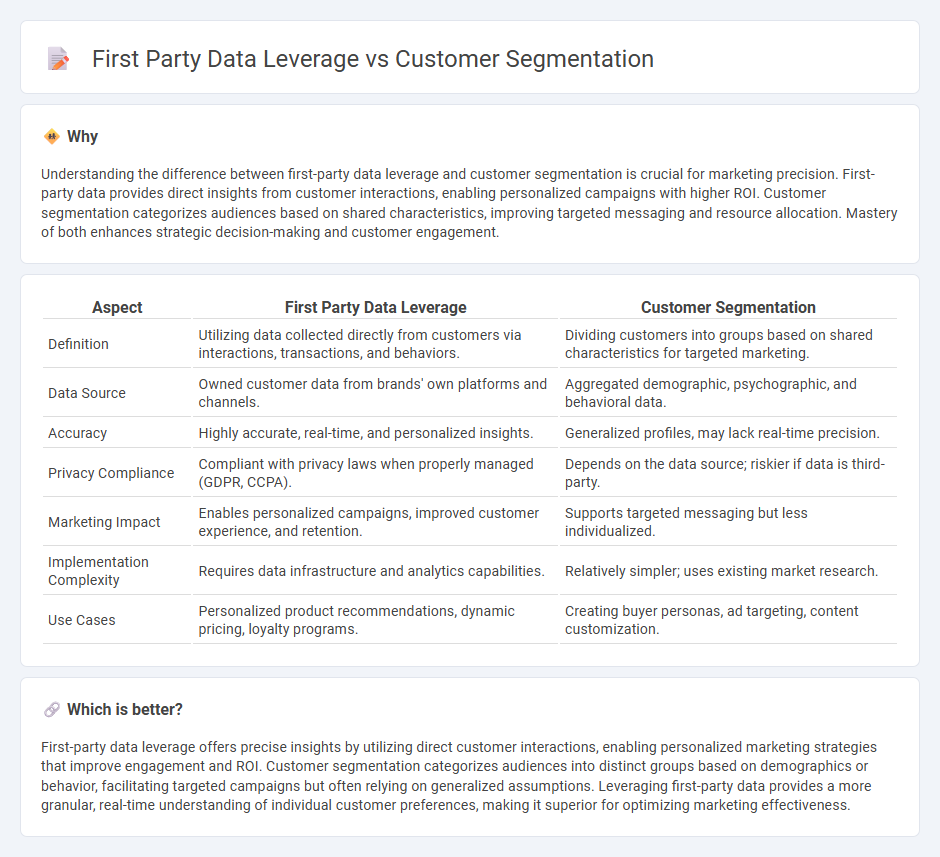
First-party data provides businesses with accurate, personalized insights directly from their customer interactions, enabling more effective and targeted marketing strategies compared to traditional customer segmentation. Leveraging this data enhances customer experience by delivering relevant content based on real behavior and preferences. Explore how first-party data can transform your marketing approach and drive higher engagement.
Why it is important
Understanding the difference between first-party data leverage and customer segmentation is crucial for marketing precision. First-party data provides direct insights from customer interactions, enabling personalized campaigns with higher ROI. Customer segmentation categorizes audiences based on shared characteristics, improving targeted messaging and resource allocation. Mastery of both enhances strategic decision-making and customer engagement.
Comparison Table
| Aspect | First Party Data Leverage | Customer Segmentation |
|---|---|---|
| Definition | Utilizing data collected directly from customers via interactions, transactions, and behaviors. | Dividing customers into groups based on shared characteristics for targeted marketing. |
| Data Source | Owned customer data from brands' own platforms and channels. | Aggregated demographic, psychographic, and behavioral data. |
| Accuracy | Highly accurate, real-time, and personalized insights. | Generalized profiles, may lack real-time precision. |
| Privacy Compliance | Compliant with privacy laws when properly managed (GDPR, CCPA). | Depends on the data source; riskier if data is third-party. |
| Marketing Impact | Enables personalized campaigns, improved customer experience, and retention. | Supports targeted messaging but less individualized. |
| Implementation Complexity | Requires data infrastructure and analytics capabilities. | Relatively simpler; uses existing market research. |
| Use Cases | Personalized product recommendations, dynamic pricing, loyalty programs. | Creating buyer personas, ad targeting, content customization. |
Which is better?
First-party data leverage offers precise insights by utilizing direct customer interactions, enabling personalized marketing strategies that improve engagement and ROI. Customer segmentation categorizes audiences into distinct groups based on demographics or behavior, facilitating targeted campaigns but often relying on generalized assumptions. Leveraging first-party data provides a more granular, real-time understanding of individual customer preferences, making it superior for optimizing marketing effectiveness.
Connection
First-party data enables precise customer segmentation by providing accurate insights into individual behaviors, preferences, and interactions. Leveraging this data allows marketers to create personalized campaigns that increase engagement and conversion rates. Effective segmentation based on first-party data enhances targeting accuracy, driving higher ROI and customer loyalty.
Key Terms
Demographic Profiling
Customer segmentation through demographic profiling categorizes audiences based on age, gender, income, education, and geographic location to tailor marketing strategies effectively. Leveraging first-party data enhances segmentation accuracy by utilizing actual consumer behaviors and preferences collected directly from users, improving personalization and targeting precision. Explore how combining demographic profiling with first-party data can drive impactful customer insights and marketing success.
Data Ownership
Customer segmentation involves categorizing consumers based on demographics, behaviors, and purchasing patterns, enabling targeted marketing strategies. First-party data leverage emphasizes data ownership, allowing businesses to collect, manage, and utilize customer information directly for personalized experiences and improved privacy compliance. Explore how mastering data ownership can enhance both customer segmentation accuracy and marketing effectiveness.
Personalized Targeting
Customer segmentation divides audiences based on demographic, behavioral, and psychographic data to create targeted marketing strategies. First-party data leverage involves collecting and analyzing data directly from customer interactions, enabling highly personalized targeting with increased accuracy and privacy compliance. Explore in-depth insights on optimizing personalized targeting through effective use of customer segmentation and first-party data.
 dowidth.com
dowidth.com